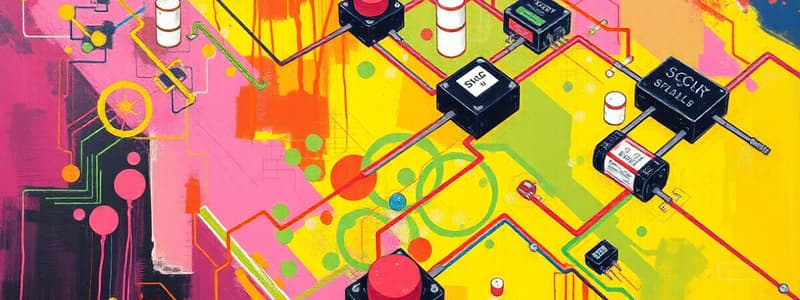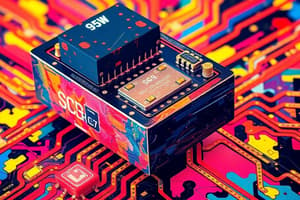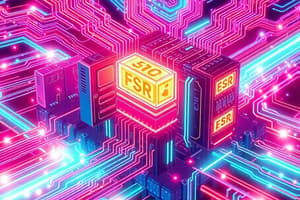Podcast
Questions and Answers
What is one of the primary advantages of using a Silicon Controlled Rectifier (SCR) over traditional diodes?
What is one of the primary advantages of using a Silicon Controlled Rectifier (SCR) over traditional diodes?
- SCRs can operate at lower voltages.
- SCRs can control high power applications. (correct)
- SCRs allow current in both directions.
- SCRs are easier to manufacture than standard diodes.
Which of the following best describes the composition of a Silicon Controlled Rectifier?
Which of the following best describes the composition of a Silicon Controlled Rectifier?
- Two layers of semiconductor material.
- A single layer of silicon material.
- Four layers of alternating P-type and N-type materials. (correct)
- Three terminal and five layer semiconductor.
After its initial development, what alternative names were often used for the Silicon Controlled Rectifier?
After its initial development, what alternative names were often used for the Silicon Controlled Rectifier?
- Thyristor and controlled rectifier. (correct)
- Diode and SCR diode.
- Transistor and BJT.
- FET and direct current converter.
Which of the following applications is NOT typically associated with Silicon Controlled Rectifiers?
Which of the following applications is NOT typically associated with Silicon Controlled Rectifiers?
What principle is the operation of a Silicon Controlled Rectifier based on?
What principle is the operation of a Silicon Controlled Rectifier based on?
Which phenomenon occurs when the forward bias voltage exceeds the breakdown voltage in an SCR?
Which phenomenon occurs when the forward bias voltage exceeds the breakdown voltage in an SCR?
What is the role of the gate in a TRIAC?
What is the role of the gate in a TRIAC?
In which region of the V-I characteristics does the SCR experience forward leakage current?
In which region of the V-I characteristics does the SCR experience forward leakage current?
What is the primary risk associated with exceeding the reverse breakdown voltage in an SCR?
What is the primary risk associated with exceeding the reverse breakdown voltage in an SCR?
What characteristic curve mode represents the first quadrant operation for a TRIAC?
What characteristic curve mode represents the first quadrant operation for a TRIAC?
What occurs at junction J2 during Forward Blocking Mode?
What occurs at junction J2 during Forward Blocking Mode?
Which operation mode of the SCR occurs when both the anode is positively charged and the gate terminal receives a positive voltage?
Which operation mode of the SCR occurs when both the anode is positively charged and the gate terminal receives a positive voltage?
What is the primary factor that allows current to flow in Forward Conducting Mode?
What is the primary factor that allows current to flow in Forward Conducting Mode?
What characteristic of the SCR remains during Reverse Blocking Mode?
What characteristic of the SCR remains during Reverse Blocking Mode?
What effect does applying a positive voltage to the gate terminal have in Forward Conducting Mode?
What effect does applying a positive voltage to the gate terminal have in Forward Conducting Mode?
What characterizes Mode 2 operation in a TRIAC?
What characterizes Mode 2 operation in a TRIAC?
Which of the following statements about DIAC is true?
Which of the following statements about DIAC is true?
What effect does the resistor R2 have in the TRIAC control circuit?
What effect does the resistor R2 have in the TRIAC control circuit?
Which of the following is a disadvantage of using TRIACs?
Which of the following is a disadvantage of using TRIACs?
What happens to a DIAC when the voltage falls below its holding current?
What happens to a DIAC when the voltage falls below its holding current?
What is the purpose of adding external resistance in triac operations?
What is the purpose of adding external resistance in triac operations?
What is the relationship between the break over voltage and the symmetrical properties of a DIAC?
What is the relationship between the break over voltage and the symmetrical properties of a DIAC?
Which triggering method utilizes light to turn on an SCR?
Which triggering method utilizes light to turn on an SCR?
What occurs during forward voltage triggering just before the SCR turns ON?
What occurs during forward voltage triggering just before the SCR turns ON?
What is a key drawback of temperature triggering in SCR operation?
What is a key drawback of temperature triggering in SCR operation?
What characteristic makes DIAC advantageous in reducing harmonics within a system?
What characteristic makes DIAC advantageous in reducing harmonics within a system?
In dV/dt triggering, what phenomenon allows the SCR to turn ON?
In dV/dt triggering, what phenomenon allows the SCR to turn ON?
Which of the following best describes the primary limitation of a DIAC?
Which of the following best describes the primary limitation of a DIAC?
What is a notable disadvantage of gate triggering using a DC supply?
What is a notable disadvantage of gate triggering using a DC supply?
Which of the following best describes forward blocking mode in SCR operation?
Which of the following best describes forward blocking mode in SCR operation?
In the two transistor analogy of SCR, which condition must be satisfied for the transistors to enter saturation?
In the two transistor analogy of SCR, which condition must be satisfied for the transistors to enter saturation?
What happens during the latch-up phase of an SCR's turn-on mechanism?
What happens during the latch-up phase of an SCR's turn-on mechanism?
Which mode of SCR operation should be avoided to prevent damage?
Which mode of SCR operation should be avoided to prevent damage?
What is the significance of symmetrical triggering in TRIACs when using a DIAC?
What is the significance of symmetrical triggering in TRIACs when using a DIAC?
What condition leads to the conduction of the SCR in gate triggering?
What condition leads to the conduction of the SCR in gate triggering?
Which of the following statements about SCR triggering methods is incorrect?
Which of the following statements about SCR triggering methods is incorrect?
Which of the following statements about the SCR's reverse blocking mode is true?
Which of the following statements about the SCR's reverse blocking mode is true?
Which of the following is NOT a typical application of a DIAC?
Which of the following is NOT a typical application of a DIAC?
What does the holding current represent in the context of an SCR?
What does the holding current represent in the context of an SCR?
In SCR theory, which equation represents the relationship of anode current and gate current when leakage currents are negligible?
In SCR theory, which equation represents the relationship of anode current and gate current when leakage currents are negligible?
Flashcards
SCR
SCR
A 3-terminal, 4-layer semiconductor device used for controlling high-power currents.
Silicon Controlled Rectifier (SCR)
Silicon Controlled Rectifier (SCR)
A unidirectional current controller; a 4-layer semiconductor device that rectifies high AC currents to DC, capable of handling high voltages.
Thyristor
Thyristor
Alternative name for a Silicon Controlled Rectifier (SCR).
4-layer diode
4-layer diode
Signup and view all the flashcards
Rectifier
Rectifier
Signup and view all the flashcards
SCR Forward Blocking Region
SCR Forward Blocking Region
Signup and view all the flashcards
SCR Forward Conduction Region
SCR Forward Conduction Region
Signup and view all the flashcards
SCR Reverse Blocking Region
SCR Reverse Blocking Region
Signup and view all the flashcards
TRIAC Operation
TRIAC Operation
Signup and view all the flashcards
TRIAC Characteristic Modes
TRIAC Characteristic Modes
Signup and view all the flashcards
SCR Forward Blocking Mode
SCR Forward Blocking Mode
Signup and view all the flashcards
SCR Forward Conducting Mode
SCR Forward Conducting Mode
Signup and view all the flashcards
SCR Reverse Blocking Mode
SCR Reverse Blocking Mode
Signup and view all the flashcards
SCR Construction
SCR Construction
Signup and view all the flashcards
SCR Gate Terminal
SCR Gate Terminal
Signup and view all the flashcards
TRIAC Operation Mode 2
TRIAC Operation Mode 2
Signup and view all the flashcards
TRIAC Operation Mode 3
TRIAC Operation Mode 3
Signup and view all the flashcards
DIAC Function
DIAC Function
Signup and view all the flashcards
DIAC Construction
DIAC Construction
Signup and view all the flashcards
DIAC Activation
DIAC Activation
Signup and view all the flashcards
TRIAC Construction - Components for Controlling Current
TRIAC Construction - Components for Controlling Current
Signup and view all the flashcards
DIAC Breakover Voltage
DIAC Breakover Voltage
Signup and view all the flashcards
DIAC Advantages
DIAC Advantages
Signup and view all the flashcards
DIAC Disadvantages
DIAC Disadvantages
Signup and view all the flashcards
DIAC Application
DIAC Application
Signup and view all the flashcards
TRIAC Triggering
TRIAC Triggering
Signup and view all the flashcards
Two Transistor Analogy of SCR
Two Transistor Analogy of SCR
Signup and view all the flashcards
SCR Turn-on Mechanism
SCR Turn-on Mechanism
Signup and view all the flashcards
Forward Biasing (SCR)
Forward Biasing (SCR)
Signup and view all the flashcards
Holding Current
Holding Current
Signup and view all the flashcards
SCR Latch-Up
SCR Latch-Up
Signup and view all the flashcards
SCR Forward Voltage Triggering
SCR Forward Voltage Triggering
Signup and view all the flashcards
Light Triggering
Light Triggering
Signup and view all the flashcards
Temperature Triggering
Temperature Triggering
Signup and view all the flashcards
dv/dt Triggering
dv/dt Triggering
Signup and view all the flashcards
Gate Triggering
Gate Triggering
Signup and view all the flashcards
Forward Blocking Mode
Forward Blocking Mode
Signup and view all the flashcards
Forward Conduction Mode
Forward Conduction Mode
Signup and view all the flashcards
Reverse Blocking Mode
Reverse Blocking Mode
Signup and view all the flashcards
Gate Triggering Method
Gate Triggering Method
Signup and view all the flashcards





